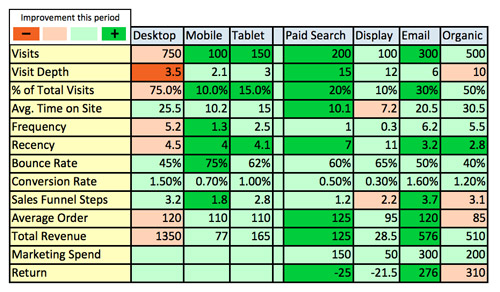5 Simple Steps for Creating a Digital Marketing Strategy
Would you like some simple steps for creating an effective game plan for your digital marketing efforts? In a recent presentation to the Houston AMA, Kashif Khurshid of Waste Management laid out such a plan. Combining data-collecting tactics with essential management requirements, this short outline is an excellent overview for anyone who wants to get more from their marketing efforts. From creating an effective campaign to nurturing a prospect through to conversion, the key is in the data.
1. Tag your traffic
When you drive people from any digital channel to your website, it's important to tag your links logically. Your website analytics software should allow for tags beyond just the landing page. Every campaign and every channel should be coded distinctly into your link. For example, change
http://www.website.com/landing.html
to:
http://www.website.com/landing.html?utm_source=LoyaltyCustomer&utm_medium=email&utm_content=Mens_Gucci_SKU123&utm_campaign=Spring_Menswear
or, if you prefer, roll all your information into one parameter that can be parsed out like:
http://www.website.com/landing.html?CID=CustomerLoyalty_email_MensGucciSKU123_SpringMenswear.
The more detailed your traffic reporting is, the easier it is to drill down into the specifics and then change what is not working so you can capitalize on your successes.
2. Segment your audience
With all the data available to marketers, it's amazing how many brands continue to "blast" the same message to their entire list. Demographic information like age, gender and income is a start, but by matching purchase history with available offers and content, the relevance of your emails keeps your customers engaged for a longer span of time. You can also use information from previous campaigns to further segment by geography, time of day, channel/device and more. Where segmenting once mainly applied to direct pushes like direct mail and email, the capabilities of digital ad networks make targeting more and more effective.
3. Create a campaign scorecard
Once you are tracking the source of your traffic in-store and online, create a living scorecard that looks at key metrics broken out by your defined segments. Here's what a sample scorecard might look like:

Of course, your main focus should be on conversions and ROI. However, with good analytics, you can also calculate an average lifetime value (LTV) by channel, which is a critical measure when evaluating the success of your prospecting efforts. This is the kind of reporting that can help refine campaign strategy or, applied generally, can even help shape an entire business plan!
4. Take informed action.
Apply the valuable analytics you glean to then refine your marketing. Your marketing plan should always be a cycle of building on successes and eliminating waste.
a. Measure and optimize marketing effectiveness.
b. Use predictive modeling for recurring campaigns.
c. Optimize design and content on your landing pages.
d. Review the user's experience through the online (or offline) sales funnel. Eliminate roadblocks or hurdles that cause abandonment.
e. Add personalization to communications to increase relevance and customer engagement.
5. Create an organized structure.
For overall success, it's important to create and follow a regimented structure. A common pitfall in marketing is working on campaigns/projects one at a time, racing from deadline to deadline. It's a difficult rut to get out of, but creating a broader vision and plan is essential.
a. First, get your decision-makers on board. Upgrading your marketing strategy can involve an investment of time and money.
b. Connect silos of digital data via a marketing dashboard that can be used by all the relevant managers.
c. Standardize processes for better analytics across campaigns.
d. Create benchmarks for constant improvement.
In the past, direct marketing success was measured by a response analysis based on sales. If the marketer was really good, they would also create customer segments based on demographics and purchase history and apply them to future campaigns. But now, with the power of web analytics, prospects can be nurtured through the sales funnel even before they make their first purchase. With this additional piece of the puzzle, marketing executives have unprecedented power in their data. By using using campaign metrics to set goals for a campaign, they can create informed tactics and deploy the next campaign with confidence. A never-ending cycle of success.
Kashif Khurshid is Sr. Strategist of Web Analytics, Waste Management and his presentation can found at:
http://www.captainanalytics.com/2015/04/going-beyond-first-click.html?CID=idfour_insights
